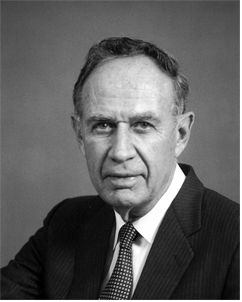Dr. Philip W. Lett
 Armed with a Ph.D. in mechanical engineering
from the University of Michigan, Dr. Philip W. Lett joined Chrysler Defense Operations in 1950, beginning a
life-long association with armored vehicle research and development.
Armed with a Ph.D. in mechanical engineering
from the University of Michigan, Dr. Philip W. Lett joined Chrysler Defense Operations in 1950, beginning a
life-long association with armored vehicle research and development.
He was first involved in the development of the M48 series tank. As project engineer, he supervised the technical effort and coordinated with the Army in the test and evaluation process. The M48 contained numerous design firsts, the one piece cast turret and hull permitted seamless gradations in the thickness of its armor and optimized ballistic protection, and, largely as a result of Dr. Lett's contributions in fire control design and development, it was the first US tank with a rangefinder and ballistic computer.
In 1954, Dr. Lett became Chief Engineer with major responsibilities for the Army's next main battle tank, the M60. The M60 tank incorporated numerous improvements, many of which were retrofitted to the M48. Much to Dr. Lett's credit, the M60 accepted a much larger, 105mm gun and took advantage of an air-cooled diesel engine which was much less susceptible to catching fire than the gasoline engines initially used in the M48 series tanks.
In 1972, when the Army launched its XM-1 tank program and provided development and unit-cost requirements to potential manufacturers, Dr. Lett led General Dynamics' design and development team efforts to win the contract. His team won the competition against General Motors by best meeting the Army's stringent performance and reliability specifications at a lower unit production cost. For the remainder of his career, Dr. Lett led the General Dynamics Land Systems' team through the development, testing, and production of the M1 Abrams Tank and its follow-on variants. He and his team were responsible for many of the series innovative features—compartmentalized ammunition, composite armor, a 120mm main gun, the first ever tank turbine engine, an excellent suspension system, and a stabilized fire control system—and ultimately a combat weapon system of unprecedented power and speed with the first truly successful, high-speed "shoot-on-the-move" capability. As a result, he is generally considered to be the "Father of the M1 Tank," the 20th Century's finest armored fighting vehicle and one which will serve US Army well for many years to come.
The success of Dr. Lett's efforts were clearly demonstrated during Operation Desert Storm, when M1 tanks destroyed more than 2,000 enemy tanks while suffering only 18 damaged M1s in return.
Upon retirement, Dr. Lett continues as a consultant to General Dynamics, and his advice on armor vehicle design is sought worldwide.